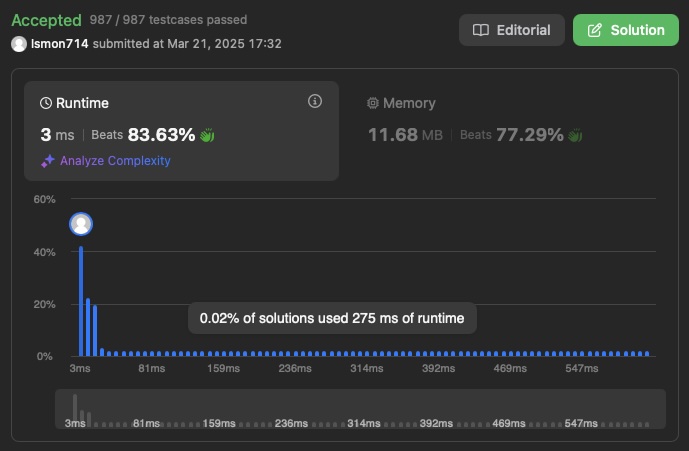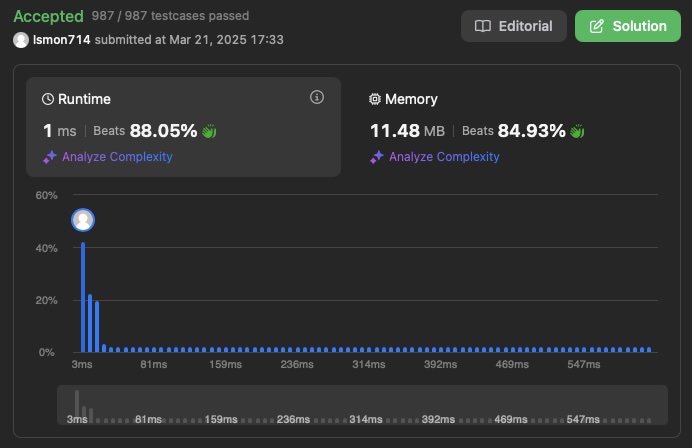3. Longest substring



Problem
Given a string s, find the length of the longest substring without duplicate characters.
Example 1
Input: s = "abcabcbb"
Output: 3
Explanation: The answer is "abc", with the length of 3.
Example 2
Input: s = "bbbbb"
Output: 1
Explanation: The answer is "b", with the length of 1.
Example 3
Input: s = "pwwkew"
Output: 3
Explanation: The answer is "wke", with the length of 3.
Notice that the answer must be a substring, "pwke" is a subsequence and not a substring.
Brute Force

Intuition
I thought of using a sliding window to find duplicates and a map that tracks the precense and position of character
Approach
I thought of using sliding window to find the longest non repeating substring.
- Initialize 2 pointers (start and end) that mark the range of the sliding window.
- Iterate throguth the input string
supdating the start pointer if we encounter a duplicated character and moving the end pointer processing the next character. - After iterating thorugh all characters in the string return the maximum length found during the process.
Time complexity
I believe that the works case scenario can be $O(n^2)$ because not only hast to go through the length of the string but also go through the map I am adding characters each time making it work dobule duty if the map is pretty full.
Space complexity
$O(min(m,n))$ where m is the size of the character set (for example 128 for ASCII) and n which is the length of the string and due to the unordered_map that store characters which stores only unique characters seen in the current window.
Code
class Solution {
public:
int lengthOfLongestSubstring(string s) {
if (s.empty()) return 0;
int start = 0, maxLen = 0;
unordered_map<char, int> map;
for(int end = 0; end < s.size(); end++) {
char c = s[end];
if (map.count(c) && map[c] >= start) {
start = map[c] + 1;
}
map[c] = end; // Update last position of current character
maxLen = std::max(maxLen, end - start + 1);
}
return maxLen;
}
};
Optimized approach

Intuition
Based on my approach on the brute force approach where I used an unordered_map to do the character counting. And thinking I could get eliminate the map using an array representing the 128 charactors of the ASCII code.
Approach
- Terying to reduce the number of map operations
- Using a more space efficent data structure for the characters.
- Minimizing the updates of variables.
-
Array instead of Hash Map:
- Uses a fixed-size array (128 for ASCII) instead of unordered_map
- Constant time O(1) lookups vs. average O(1) with potential collisions
- Less memory overhead
-
Single Pass Efficiency:
- Eliminates the need for map.count() checks
- Combines the position check and update in one step
- Uses array initialization to avoid explicit clearing
-
Reduced Operations:
- Stores position+1 to avoid adding 1 later
- Uses running max to avoid recalculation
Time complexity:
Removing worst case scenarios (hash map operations) and having a more constant $O(n)$
Space complexity:
Brute force: $O(min(m, n))$
Now: $O(128)$ (128 ASCI characters) => $O(1)$
Code
class Solution {
public:
int lengthOfLongestSubstring(string s) {
if (s.empty()) return 0;
int lastSeen [128] = {0};
int maxLen = 0, start = 0;
for (int end = 0; end < s.size(); end++) {
start = std::max(start, lastSeen[s[end]]);
maxLen = std::max(maxLen, end -start + 1);
lastSeen[s[end]] = end + 1;
}
return maxLen;
}
};